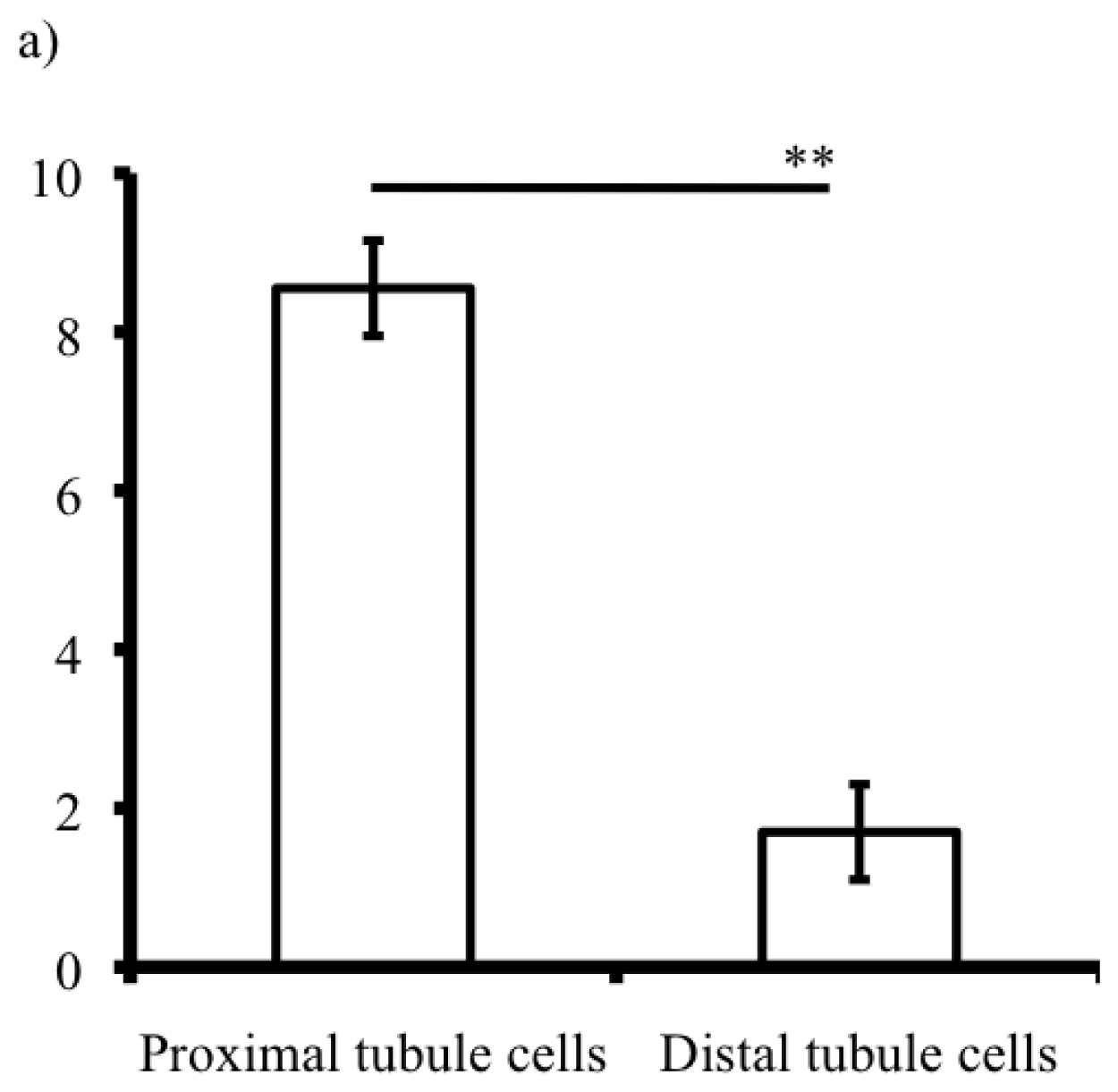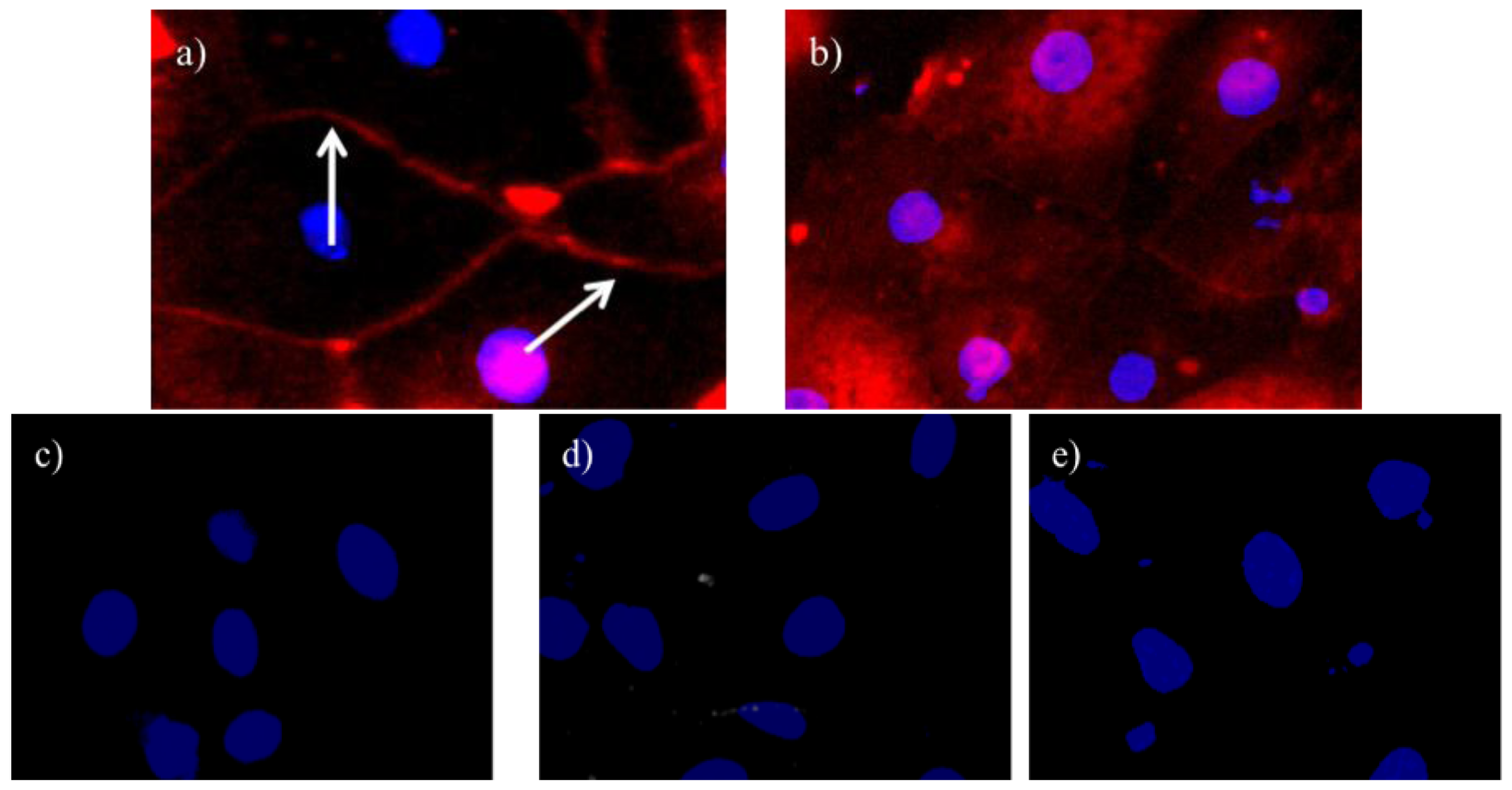The Establishment of a Primary Culture System of Proximal Tubule Segments Using Specific Markers from Normal Mouse Kidneys
Abstract
:1. Introduction
2. Results and Discussion
2.1. Primary Culture of Proximal Tubules
2.2. Characterization of Proximal Tubules
2.3. Separation and Characterization of Proximal Tubule Cells from the S1, S2, and S3 Segments
2.4. AGT mRNA and Protein Expression in S1, S2, and S3 Proximal Tubule Cells
2.5. Discussion
3. Experimental Section
3.1. Isolation of Kidney Tubules
3.2. Primary Culture of Proximal Tubule Cells
3.3. Separation of Proximal Tubule Cells
3.4. Alkaline Phosphatase Activity
3.5. Immunocytochemistry
3.6. Quantitative Real-Time RT-PCR
3.7. Western Blot
3.8. Statistical Analysis
4. Conclusions
Acknowledgments
- Conflict of Interest The authors declare no conflict of interest.
References
- Tang, M.J.; Suresh, K.R.; Tannen, R.L. Carbohydrate metabolism by primary cultures of rabbit proximal tubules. Am. J. Physiol 1989, 256, C532–C539. [Google Scholar]
- Vinay, P.; Gougoux, A.; Lemieux, G. Isolation of a pure suspension of rat proximal tubules. Am. J. Physiol 1981, 241, F403–F411. [Google Scholar]
- Gesek, F.A.; Wolff, D.W.; Strandhoy, J.W. Improved separation method for rat proximal and distal renal tubules. Am. J. Physiol 1987, 253, F358–F365. [Google Scholar]
- Taub, M. Primary kidney cells. Methods Mol. Biol 1997, 75, 153–161. [Google Scholar]
- Taub, M.; Chuman, L.; Saier, M.H., Jr; Sato, G. Growth of Madin-Darby canine kidney epithelial cell (MDCK) line in hormone-supplemented, serum-free medium. Proc. Natl. Acad. Sci. USA 1979, 76, 3338–3342. [Google Scholar]
- Chuman, L.; Fine, L.G.; Cohen, A.H.; Saier, M.H., Jr. Continuous growth of proximal tubular kidney epithelial cells in hormone-supplemented serum-free medium. J. Cell Biol 1982, 94, 506–510. [Google Scholar]
- Taub, M.; Sato, G. Growth of functional primary cultures of kidney epithelial cells in defined medium. J. Cell. Physiol 1980, 105, 369–378. [Google Scholar]
- Chung, S.D.; Alavi, N.; Livingston, D.; Hiller, S.; Taub, M. Characterization of primary rabbit kidney cultures that express proximal tubule functions in a hormonally defined medium. J. Cell Biol 1982, 95, 118–126. [Google Scholar]
- Rubera, I.; Tauc, M.; Bidet, M.; Poujeol, C.; Cuiller, B.; Watrin, A.; Touret, N.; Poujeol, P. Chloride currents in primary cultures of rabbit proximal and distal convoluted tubules. Am. J. Physiol 1998, 275, F651–F663. [Google Scholar]
- Merot, J.; Bidet, M.; Gachot, B.; Le Maout, S.; Tauc, M.; Poujeol, P. Patch clamp study on primary culture of isolated proximal convoluted tubules. Pflugers Arch. Eur. J. Physiol 1988, 413, 51–61. [Google Scholar]
- Terryn, S.; Jouret, F.; Vandenabeele, F.; Smolders, I.; Moreels, M.; Devuyst, O.; Steels, P.; van Kerkhove, E. A primary culture of mouse proximal tubular cells, established on collagen-coated membranes. Am. J. Physiol. Renal Physiol 2007, 293, F476–F485. [Google Scholar]
- Rahmoune, H.; Thompson, P.W.; Ward, J.M.; Smith, C.D.; Hong, G.; Brown, J. Glucose transporters in human renal proximal tubular cells isolated from the urine of patients with non-insulin-dependent diabetes. Diabetes 2005, 54, 3427–3434. [Google Scholar]
- Inoue, C.N.; Kondo, Y.; Ohnuma, S.; Morimoto, T.; Nishio, T.; Iinuma, K. Use of cultured tubular cells isolated from human urine for investigation of renal transporter. Clin. Nephrol 2000, 53, 90–98. [Google Scholar]
- Kobori, H.; Nangaku, M.; Navar, L.G.; Nishiyama, A. The intrarenal renin-angiotensin system: From physiology to the pathobiology of hypertension and kidney disease. Pharmacol. Rev 2007, 59, 251–287. [Google Scholar]
- Mazzocchi, G.; Malendowicz, L.K.; Markowska, A.; Albertin, G.; Nussdorfer, G.G. Role of adrenal renin-angiotensin system in the control of aldosterone secretion in sodium-restricted rats. Am. J. Physiol. Endocrinol. Metab 2000, 278, E1027–E1030. [Google Scholar]
- Navar, L.G.; Harrison-Bernard, L.M.; Nishiyama, A.; Kobori, H. Regulation of intrarenal angiotensin II in hypertension. Hypertension 2002, 39, 316–322. [Google Scholar]
- Kobori, H.; Harrison-Bernard, L.M.; Navar, L.G. Expression of angiotensinogen mRNA and protein in angiotensin II-dependent hypertension. J. Am. Soc. Nephrol 2001, 12, 431–439. [Google Scholar]
- Kamiyama, M.; Urushihara, M.; Morikawa, T.; Konishi, Y.; Imanishi, M.; Nishiyama, A.; Kobori, H. Augmented intrarenal angiotensinogen mRNA expression parallels renal dysfunction in patients with type 2 diabetes. Hypertension 2010, 56, e135. [Google Scholar]
- Kobori, H.; Ozawa, Y.; Suzaki, Y.; Prieto-Carrasquero, M.C.; Nishiyama, A.; Shoji, T.; Cohen, E.P.; Navar, L.G. Young scholars award lecture: Intratubular angiotensinogen in hypertension and kidney diseases. Am. J. Hypertens 2006, 19, 541–550. [Google Scholar]
- Kanai, Y.; Lee, W.S.; You, G.; Brown, D.; Hediger, M.A. The human kidney low affinity Na+/glucose cotransporter SGLT2. Delineation of the major renal reabsorptive mechanism for d-glucose. J. Clin. Invest 1994, 93, 397–404. [Google Scholar]
- Baer, P.C.; Nockher, W.A.; Haase, W.; Scherberich, J.E. Isolation of proximal and distal tubule cells from human kidney by immunomagnetic separation. Technical note. Kidney Int 1997, 52, 1321–1331. [Google Scholar]
- Kamiyama, M.; Kobayashi, M.; Araki, S.; Iida, A.; Tsunoda, T.; Kawai, K.; Imanishi, M.; Nomura, M.; Babazono, T.; Iwamoto, Y.; et al. Polymorphisms in the 3′ UTR in the neurocalcin delta gene affect mRNA stability, and confer susceptibility to diabetic nephropathy. Hum. Genet 2007, 122, 397–407. [Google Scholar]
- Christensen, B.M.; Marples, D.; Kim, Y.H.; Wang, W.; Frokiaer, J.; Nielsen, S. Changes in cellular composition of kidney collecting duct cells in rats with lithium-induced NDI. Am. J. Physiol. Cell Physiol 2004, 286, C952–C964. [Google Scholar]
- Chou, C.L.; Yip, K.P.; Michea, L.; Kador, K.; Ferraris, J.D.; Wade, J.B.; Knepper, M.A. Regulation of aquaporin-2 trafficking by vasopressin in the renal collecting duct. Roles of ryanodine-sensitive Ca2+ stores and calmodulin. J. Biol. Chem 2000, 275, 36839–36846. [Google Scholar]
- Ohashi, N.; Urushihara, M.; Satou, R.; Kobori, H. Glomerular angiotensinogen is induced in mesangial cells in diabetic rats via reactive oxygen species—ERK/JNK pathways. Hypertens. Res 2010, 33, 1174–1181. [Google Scholar]
- Bouguermouh, S.; Fortin, G.; Baba, N.; Rubio, M.; Sarfati, M. CD28 co-stimulation down regulates Th17 development. PLoS One 2009, 4. [Google Scholar] [CrossRef]
- Suljagic, M.; Longo, P.G.; Bennardo, S.; Perlas, E.; Leone, G.; Laurenti, L.; Efremov, D.G. The Syk inhibitor fostamatinib disodium (R788) inhibits tumor growth in the Emu-TCL1 transgenic mouse model of CLL by blocking antigen-dependent B-cell receptor signaling. Blood 2010, 116, 4894–4905. [Google Scholar]
- Sugawara-Yokoo, M.; Suzuki, T.; Matsuzaki, T.; Naruse, T.; Takata, K. Presence of fructose transporter GLUT5 in the S3 proximal tubules in the rat kidney. Kidney Int 1999, 56, 1022–1028. [Google Scholar]
- Vanslambrouck, J.M.; Broer, A.; Thavyogarajah, T.; Holst, J.; Bailey, C.G.; Broer, S.; Rasko, J.E. Renal imino acid and glycine transport system ontogeny and involvement in developmental iminoglycinuria. Biochem. J 2010, 428, 397–407. [Google Scholar]
- Ichihara, A.; Kobori, H.; Nishiyama, A.; Navar, L.G. Renal renin-angiotensin system. Contrib. Nephrol 2004, 143, 117–130. [Google Scholar]
- Ingelfinger, J.R.; Zuo, W.M.; Fon, E.A.; Ellison, K.E.; Dzau, V.J. In situ hybridization evidence for angiotensinogen messenger RNA in the rat proximal tubule. An hypothesis for the intrarenal renin angiotensin system. J. Clin. Invest 1990, 85, 417–423. [Google Scholar]
- Darby, I.A.; Congiu, M.; Fernley, R.T.; Sernia, C.; Coghlan, J.P. Cellular and ultrastructural location of angiotensinogen in rat and sheep kidney. Kidney Int 1994, 46, 1557–1560. [Google Scholar]
- Darby, I.A.; Sernia, C. In situ hybridization and immunohistochemistry of renal angiotensinogen in neonatal and adult rat kidneys. Cell Tissue Res 1995, 281, 197–206. [Google Scholar]
- Pohl, M.; Kaminski, H.; Castrop, H.; Bader, M.; Himmerkus, N.; Bleich, M.; Bachmann, S.; Theilig, F. Intrarenal renin angiotensin system revisited: Role of megalin-dependent endocytosis along the proximal nephron. J. Biol. Chem 2010, 285, 41935–41946. [Google Scholar]
- Terada, Y.; Tomita, K.; Nonoguchi, H.; Marumo, F. PCR localization of angiotensin II receptor and angiotensinogen mRNAs in rat kidney. Kidney Int 1993, 43, 1251–1259. [Google Scholar]
- Yanagawa, N.; Capparelli, A.W.; Jo, O.D.; Friedal, A.; Barrett, J.D.; Eggena, P. Production of angiotensinogen and renin-like activity by rabbit proximal tubular cells in culture. Kidney Int 1991, 39, 938–941. [Google Scholar]
- Kamiyama, M.; Farragut, M.K.; Kobori, H. Divergent localizations of angiotensinogen mRNA and protein in proximal tubular segments of normal rat kidney. Hypertension 2011, 57, e78. [Google Scholar]
- Melis, M.; Krenning, E.P.; Bernard, B.F.; Barone, R.; Visser, T.J.; de Jong, M. Localisation and mechanism of renal retention of radiolabelled somatostatin analogues. Eur. J. Nucl. Med. Mol. Imaging 2005, 32, 1136–1143. [Google Scholar]
- Kamiyama, M.; Farragut, M.K.; Sofue, T.; Hara, T.; Nishiyama, A.; Kobori, H. Specified proximal tubular segments of augmented angiotensinogen mRNA and protein expression in diabetic rat kidney. Hypertension 2011, 57, e127. [Google Scholar]
- Kobori, H.; Ozawa, Y.; Satou, R.; Katsurada, A.; Miyata, K.; Ohashi, N.; Hase, N.; Suzaki, Y.; Sigmund, C.D.; Navar, L.G. Kidney-specific enhancement of ANG II stimulates endogenous intrarenal angiotensinogen in gene-targeted mice. Am. J. Physiol. Renal Physiol 2007, 293, F938–F945. [Google Scholar]
- Ozawa, Y.; Kobori, H. Crucial role of Rho-nuclear factor-kappaB axis in angiotensin II-induced renal injury. Am. J. Physiol. Renal Physiol 2007, 293, F100–F109. [Google Scholar]
- Prieto-Carrasquero, M.C.; Harrison-Bernard, L.M.; Kobori, H.; Ozawa, Y.; Hering-Smith, K.S.; Hamm, L.L.; Navar, L.G. Enhancement of collecting duct renin in angiotensin II-dependent hypertensive rats. Hypertension 2004, 44, 223–229. [Google Scholar]
- Kobori, H.; Ozawa, Y.; Suzaki, Y.; Nishiyama, A. Enhanced intrarenal angiotensinogen contributes to early renal injury in spontaneously hypertensive rats. J. Am. Soc. Nephrol 2005, 16, 2073–2080. [Google Scholar]







© 2012 by the authors; licensee Molecular Diversity Preservation International, Basel, Switzerland. This article is an open-access article distributed under the terms and conditions of the Creative Commons Attribution license (http://creativecommons.org/licenses/by/3.0/).
Share and Cite
Kamiyama, M.; Garner, M.K.; Farragut, K.M.; Kobori, H. The Establishment of a Primary Culture System of Proximal Tubule Segments Using Specific Markers from Normal Mouse Kidneys. Int. J. Mol. Sci. 2012, 13, 5098-5111. https://doi.org/10.3390/ijms13045098
Kamiyama M, Garner MK, Farragut KM, Kobori H. The Establishment of a Primary Culture System of Proximal Tubule Segments Using Specific Markers from Normal Mouse Kidneys. International Journal of Molecular Sciences. 2012; 13(4):5098-5111. https://doi.org/10.3390/ijms13045098
Chicago/Turabian StyleKamiyama, Masumi, Michelle K. Garner, Kristina M. Farragut, and Hiroyuki Kobori. 2012. "The Establishment of a Primary Culture System of Proximal Tubule Segments Using Specific Markers from Normal Mouse Kidneys" International Journal of Molecular Sciences 13, no. 4: 5098-5111. https://doi.org/10.3390/ijms13045098



